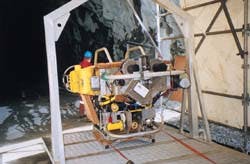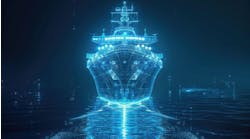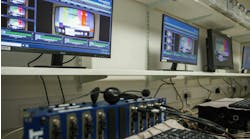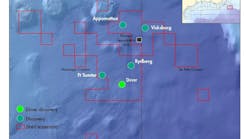(Left) The Sea Twin ROV fully equipped for inspecting the Troll landfall tunnels. (Right) A view of the Troll tunnels as seen through the eyes of the 3D model.
A novel inspection and reporting system which makes use of virtual reality, multimedia and 3D modeling techniques has been developed for use in the Troll Gas landfall tunnels. The complex of tunnels is almost eight km long; the main tunnel is some 3.7 km long, eight metres high, nine metres wide and at its deepest point some 235 metres below sea level. Through the tunnels run two 36-in pipelines bringing the gas/condensate stream from the Troll Gas platform to the Kollsnes processing plant, and two 40-inch pipelines carrying dry gas exports from the plant to Continental Europe. The pipelines have been covered with crushed rock, though parts have been left exposed. The tunnels are water-filled. The Troll gas facilities put in place by Norske Shell as the development operator are expected to remain in operation for at least 50 years. Among the Troll Gas Project's functional specifications was the capability of inspecting the tunnel complex at any time, in order to check its structural integrity and identify at an early stage any corrective maintenance requirements.
This was a challenging assignment, according to Johann Kuhlmann, project leader for the tunnel inspection system. The system had to be capable of:
- detecting damage or irregularities over a total area, including roof and walls, of some 260,000 sq metres, and of locating the position of such features to within +/- 0.5 metres;
- operating underwater in external pressures of up to 24 bar and in an environment offering limited or no visibility, and which precluded the use of acoustic and magnetic based positioning methods;
- operating at almost twice the distance previously achieved in ROV-based inspection tasks (two kilometres).
In addition the reporting system had to make it possible to compare past and present survey data, and to present the survey data both concisely and in an accessible manner, using a multimedia format.
In 1993 Norske Shell commissioned Dolphin DOC to propose a suitable inspection method. "We concluded that we would be able to access the whole tunnel system using a standard ROV," says Svein Erik Skjei, Dolphin engineering manager. "But we wouldn't be able to use standard inspection procedures." The ROV selected was Sutec's powerful Sea Twin. Lake tests showed that it was quite capable of traveling four km while pulling an umbilical. With a number of corners to be negotiated, the drag force on the ROV when it is at the farthest part of the complex is close to 600 newtons. The umbilical itself is fairly standard though extremely rugged in order to cope with the special environment of the tunnel, Skjei says. Due to the profile of the tunnel, it has been given a slight negative buoyancy to avoid it rubbing against the tunnel roof, as this could cause a considerable increase in friction force.
Over such a length of cable, the power drop has to be taken into account, since too great an increase in core size could cause the umbilical to become unmanageable.
The ROV is fitted with standard inspection kit - a silicone intensified target camera, which supplies video images in low light, and two types of sonar, one for giving the tunnel profile and another for close-up inspection.
The specially made umbilical permits the ROV to inspect all parts of the 3.7-km tunnel complex.
Defect detection
One of the problems with using standard inspection procedures was how to identify the position of a defect or irregularity with sufficient precision, Skjei says. A magnetic compass could not be used because of interference from the pipelines, while acoustic positioning was not feasible because of echoes from the tunnel walls. Instead yellow sonar reflecting markers have been placed the length of the tunnel complex, each with its own identification. These enable the ROV's position between two markers to be accurately calculated. Its heading is calculated by using data from various sensors such as a Doppler velocity log, sonars, and depth gauge. Given the ROV's position and heading, the exact position of any defect can also be calculated to within the required limit.
Dolphin commissioned Morrison McLean Associates of Aberdeen to develop the inspection system. The chosen solution was to produce a complete 3D model of the complex as a reference point for locating the exact position of the ROV. A laser survey of the tunnel was performed before it was flooded, from which Morrison McLean constructed the model. It is displayed in remarkably life-like form on a powerful Indigo-2 High Impact computer supplied by Silicon Graphics, whose support in terms of both hardware and software contributed greatly to the success of the project, according to Kuhlmann.
Through the software developed by Morrison McLean, the current position of the ROV can be displayed on the 3D model. The pilot can therefore use the display as a visual guide as he flies the ROV through the tunnel, according to Morrison McLean managing director George Morrison. A tour of inspection can also be planned, with warnings automatically given to the pilot when he is approaching previously spotted irregularities. Again, the model can be used to simulate ROV maneuvers to check that they are feasible.
Morrison McLean has also developed a multi media-based reporting system to display inspection results. The system shows features discovered in the previous survey and marks their location on the 3D model. Associated information in the form of video images, audio comments, cathodic protection readings, text files and sonar records can also be accessed. Because the reporting system only shows those parts that have changed or are otherwise of interest, data storage requirements are much reduced, and the survey results could be transferred onto a single CD-ROM, Morrison says.
The first inspection, which took a week, was carried out in May, following tests and interface trials in the tunnel to fine-tune the sensors and debug the software. Some minor cracks not requiring repair were detected - these will be re-visited during the next inspection, Kuhlmann says.
An instrument of 60 kg weight, located 1.7 km down the tunnel, did not function to the specified requirements. A four-wheeled vehicle with a manipulator was built, and, using the same umbilical and winch as for the ROV, sent into the tunnel to retrieve the instrument. It was then found that a fault had
developed in the cable connecting the instrument with its surface station, and this is now to be replaced, using the same intervention vehicle, Skjei says.
The technology has been confirmed to be adaptable for use in all areas of subsea intervention where divers cannot be used, whether for practical or cost reasons. Deep-water installation and maintenance operations, and surveys of concrete platforms, are two obvious applications. Eventually the sight of an ROV operator using a virtual reality headset to follow his vehicle in real time as it performs its task should become common, Kuhlmann says.
Moving beyond the offshore industry, the technology could prove applicable to activities in hazardous areas in which ROVs, robots and other forms of remotely operated appliances are used instead of humans, he says. These include bomb disposal, activities within radioactive environments and space operations.
Copyright 1996 Offshore. All Rights Reserved.




